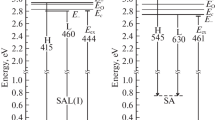Summary
In this paper, a lately proposed model is used to explain some features of the a.c. electroluminescence process in Cu-doped ZnS. The model is based on the properties of stacking-fault-type linear defects lying in basal planes of hexagonal crystals. Theoretical kinetic equations are deduced to represent the behaviour of the mean value of brightness waves. These equations are compared with the observed initial building-up of luminescence. Particular attention is given to the effect of temperature. It is found, through a comparison between experimental and theoretical results, that the decrease of the mean brightness at low temperature is due to the increasing width of the forbidden-energy gap inside the linear defective regions. All the observed facts appear self-consistent if compared with the model.
Riassunto
In questo articolo, alcune caratteristiche della elettroluminescenza a.c. nello ZnS drogato con Cu sono spiegate in base ad un modello proposto di recente. Il modello è basato sulle proprietà di difetti lineari giacenti nei piani basali dei cristalli esagonali e dovuti ad errori di impilaggio. Vengono dedotte equazioni teoriche per la cinetica, capaci di rappresentare il comportamento medio delle onde di brillanza. Queste equazioni sono messe a confronto con l’andamento iniziale delle onde di brillanza. Si trova, attraverso un paragone tra risultati sperimentali e teorici che la diminuzione di brillanza a bassa temperatura è dovuta all’accresciuta larghezza del intervallo di energia proibita all’interno della regione lineare difettosa. Tutti i fatti osservati appaiono in reciproco accordo se paragonati col modello.
Реэюме
В зтой статье испольэуется недавно предложенная модель для общяснения некоторых особенностей процесса злектролюминес ценции под действием переменного тока в ZnS с присадкой Си. Эта модель основывается на свойствах линейных дефектов, типа дефектов упаковки, лежаших в баэисных плоскостях гексо-гональных кристаллов. Выводятся теоретические кинетические уравнения, чтобы представить поведение средней величины волн яркости. Эти уравнения сравниваются с наблюденной начальной эастройкой люминесценции. Особое внимание уделяется влиянию температуры. Иэ сравнения между зкспериментальными и теоретическими реэультатами получено, что уменьщение средней яркости при ниэкой температуре обусловлено увеличением щирины эапрешенной знергетической шели внутри областей линейных дефектов. Все наблюденные факты окаэываются само-согласованными, при сравнении их с рассматриваемой моделью.
Similar content being viewed by others
References
G. Bonfiglioli andP. Brovetto:Ric. Scien.,38, 423 (1968).
G. Bonfiglioli, P. Brovetto, G. Busca andA. Mojoni: to be published.
V. E. Oranovskii andB. A. Khmelinin:Opt. Spectr.,7, 336 (1959).
J. L. Gillson andF. J. Darnell:Phys. Rev.,125, 149 (1962).
G. Bonfiglioli, P. Brovetto andA. Mojoni:Proc. Inter. Symp. on Luminescence (Munich, 1965), p. 378.
See for instance:S. Amelinckx:The Direct Observations of Dislocations (New York, 1964), p. 280.
P. Manca:Journ. Phys. Chem. Sol.,20, 268 (1961).
A. G. Fischer:Solid-State Electr.,2, 232 (1961).
R. G. Wheeler andJ. C. Miklosz:Proc. VII Int. Conf. Physics of Semiconductors (Paris, 1964), p. 873.
H. Arbell andA. Halperin:Phys. Rev.,117, 45 (1960).
See for instance:N. F. Mott andR. W. Gurney:Electronic Process in Ionic Crystals (New York, 1940), p. 172;W. Shockley andR. C. Prim:Phys. Rev.,90, 753 (1953);A. Many andG. Rakavy:Phys. Rev.,126, 1980 (1962).
J. S. Prener andF. E. Williams:Journ. Phys. Rad.,17, 667 (1956).
M. Schon:Zeits. Naturforsch.,6 a, 287 (1951);H. A. Klasens:Journ. Electrochem. Soc.,100, 72 (1953).
D. Curie:Luminescence in Crystals (London, 1963), p. 109.
See for instance:W. Shockley:Electrons and Holes in Semiconductors (Princeton, N. J., 1950). From equations given in this book (p. 316) the currentI ed0 turns out to be\(I_{ed0} = \frac{{b\sigma _i^2 }}{{(1 + b)^2 }}\frac{{\sigma l}}{{\sigma _p L_n }}\frac{{kT}}{q}\), whereb={µ}n/µ p is the ratio of electron and hole mobilities,σ i,σ p are the conductivities of the intrinsic andp-type semi-conductors respectively,L is the diffusion length of electrons andq is the electronic charge. This expression can be applied to the present case because, apart from the actual values of the parameters and the different widths of the gap in bulk and defective regions, our situation is not substantially different from that of a conventional diode.
P. Zalm:Phil. Res. Rep.,11, 353 (1956).
F. Morehead:Journ. Electrochem. Soc.,105, 461 (1958).
C. H. Haake:Journ. Opt. Soc. Am.,47, 881 (1957).
V. Maxia andC. Muntoni:Lett. Nuovo Cimento,1, 669 (1969).
C. H. Haake:Journ. Appl. Phys.,28, 245 (1957).
Similar results were first found byZalm (see:P. Zalm:Phil Res. Rep.,11, 417 (1956). This author, however, attributes to the temperature dependence ofc also the fall of brightness at high temperature. As, on the contrary, the EL behaviour at high temperature is surely due to a quenching phenomenon common to all the ZnS(Cu) luminescence processes, this conclusion cannot be accepted as a correct one. The mistake arose, perhaps, from a not accurate enough separation ofB 0 andc contributions. In any way, this, unfortunately, forbids a quantitative comparison between the present results and those of Zalm.
Author information
Authors and Affiliations
Additional information
Work sponsored by C.N.R. under contract N. 115.0243.69.00149.
Rights and permissions
About this article
Cite this article
Brovetto, P., Maxia, V. & Muntoni, C. Kinetics of a.c. electroluminescence in ZnS. Nuovo Cimento B (1965-1970) 69, 219–240 (1970). https://doi.org/10.1007/BF02710987
Received:
Published:
Issue Date:
DOI: https://doi.org/10.1007/BF02710987




